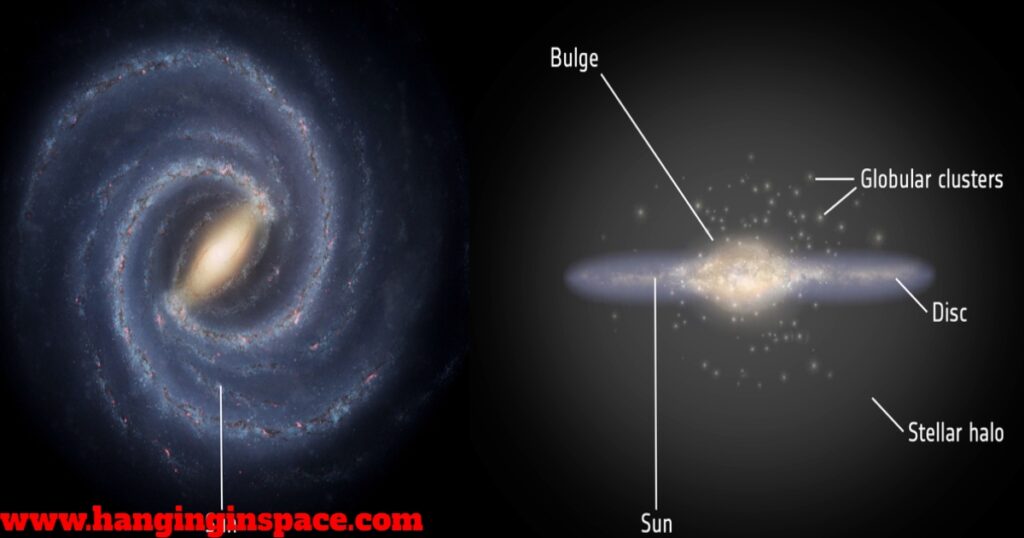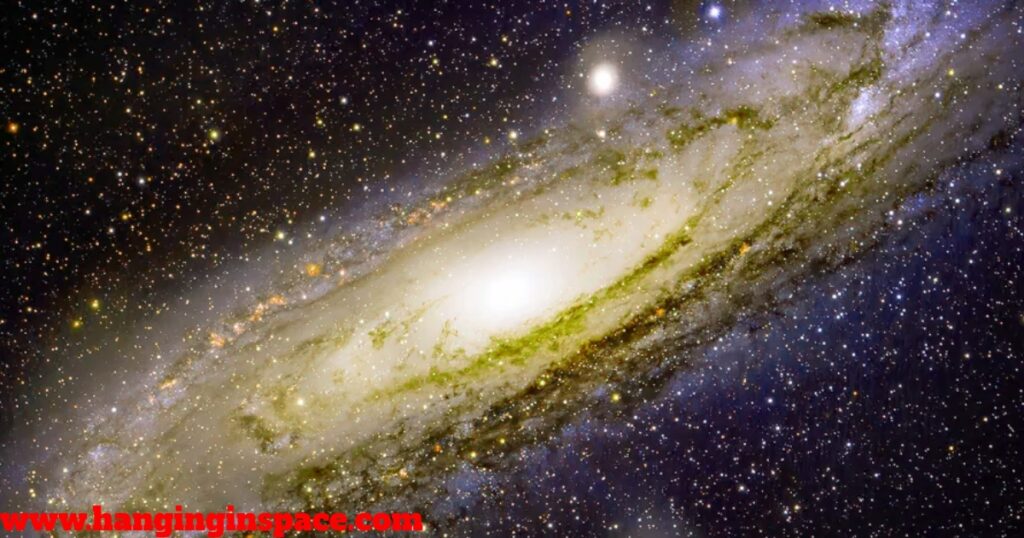The Milky Way galaxy is a vast, spiral-shaped galaxy that contains billions of stars, planets, gases, and dust held together by gravitational forces. The Milky Way Galaxy is the galaxy that contains our solar system, and the Milky Way spans a diameter of about 100,000 light years.
It is one of the billions of galaxies in the observable universe and is located in the Local Group, a small cluster of galaxies that includes the Andromeda Galaxy and several smaller galaxies. The Milky Way Galaxy is located within Laniakea Supercluster of galaxies

The Milky Way Galaxy formed from a cloud of gas and dust that fell under its own gravity, resulting in stars and galaxies. Over millennia, gravitational interactions and mergers with other galaxies altered its structure and composition, resulting in the spectacular spiral structure.
Estimates suggest that the Milky Way Galaxy contains more than 100 billion stars, which come in a variety of sizes, ages, and compositions. There could be 20 billion to 40 billion Earth-like planets in our Milky Way galaxy.
One of the Milky Way Galaxy’s most striking aspects is its vast diversity of star populations. The galaxy is a treasure mine of stellar remnants that reveal its evolutionary past, ranging from old, metal-poor stars in the galactic halo to youthful, metal-rich stars concentrated in the spiral arms.
Globular clusters, densely packed spheres of hundreds of thousands of stars, orbit the galactic core. Open clusters of young stars in the spiral arms, act as nurseries for future generations of stellar birth.
The space between stars in the Milky Way Galaxy contains an important component known as the interstellar medium (ISM). This ISM has a complicated blend of gas and particles. The gas component consists largely of hydrogen, with trace amounts of helium and heavier components.
Dust particles made of ice and stony substances are also found throughout the ISM. These interstellar clouds play an important role in the birth and death of stars, as they provide the raw material for star formation and contain the components for planetary systems.
Evidence suggests the presence of a vast amount of invisible dark matter within the Milky Way galaxy. This dark matter is thought to exert a gravitational influence, shaping the galaxy’s structure and rotation. However, its exact nature is a mystery.
What is the Structure (Anatomy) of the Milky Way Galaxy?
The Milky Way Galaxy is a barred spiral galaxy, shaped like a flattened disk with prominent spiral arms winding outwards from a central bar. This bar, believed to be a concentration of older stars, is surrounded by a bulge, a central region containing a dense collection of mostly older stars. The spiral arms, on the other hand, are cradles of star formation, teeming with young, hot stars, gas clouds, and nebulae.

1. The Nucleus:
At the very heart of the Milky Way Galaxy lies the nucleus, a densely packed region containing billions of stars. This central bulge is believed to have a supermassive black hole, Sagittarius A*, exerting a powerful gravitational influence on the surrounding stars.
2. The Central Bulge:
Surrounding the nucleus is the central bulge, a vast collection of stars extending outward in a roughly spherical shape. These stars are typically older and more metal-poor compared to those found in the disk. The bulge is thought to have formed through various processes, including mergers with smaller galaxies and the inward migration of stars from the disk.
3. The Disk:
The Milky Way boasts a flattened disk, a region containing most of the galaxy’s visible matter, including gas, dust, and younger blue stars. This disk is further divided into two components:
- Thin Disk: This is a relatively thin and dense layer where most of the star formation in the galaxy occurs. The spiral arms, iconic features of spiral galaxies, reside within the thin disk.
- Thick Disk: This is a thicker and less dense layer, containing older stars and thought to be remnants of smaller galaxies that merged with the Milky Way in the distant past.
4. The Spiral Arms:
The Spiral Arms are enormous structures that extend outward from the central bulge. Spiral arms are regions of star formation. They are powered by the presence of dense clouds of gas and dust. Young, blazing stars illuminate these arms, resulting in colorful nebulae and star clusters. Our solar system is located within the Orion Spur, a small arm of the Milky Way Galaxy.
5. The Spherical Component:
Enveloping the disk and bulge lies the spherical component. It is a vast, roughly spherical halo of stars and star clusters. This halo is much less dense than the disk and bulge but contains a significant portion of the galaxy’s total mass. It is primarily composed of older stars, including globular clusters, and ancient and tightly bound collections of millions of stars.
6. The Massive Halo:
Extending far beyond the visible components of the Milky Way Galaxy lies the massive halo. It is a region dominated by dark matter, a mysterious substance that cannot be directly observed but exerts a significant gravitational influence.

Milky Way Galaxy (Our Galaxy) as compared to NGC 262 Nebula (Largest Nebula Ever):
Milky Way Galaxy Vs. NGC 262 Nebula
| Feature | Milky Way Galaxy (Spiral Galaxy) | NGC 262 Nebula (Star-forming Nebula) |
|---|---|---|
| Type of Object | Galaxy | Nebula |
| Nature | Vast collection of stars, gas, dust, and dark matter | Cloud of gas and dust where stars are born |
| Size | Estimated diameter of 100,000 light-years (with a much larger dark matter halo) | Estimated diameter of a few light-years |
| Mass | Estimated mass of 200 to 400 billion times the Sun’s mass (including dark matter) | Can vary, but typically less than the mass of a single star |
| Light Emission | Emits light from its constituent stars | Emits faint light due to luminescence or reflection from nearby stars |
| Structure | Spiral arms, central bulge, and a surrounding halo | Diffuse and filamentary structure |
| Lifespan | Galaxies are thought to exist for billions or even trillions of years | Nebulae are dynamic and constantly evolving, eventually dispersing |
| Contents | Billions of stars, planets, dwarf planets, moons, asteroids, comets, and dust | Primarily hydrogen gas, helium gas, and dust particles |
Milky Way Galaxy (Our Galaxy) as compared to Andromeda Galaxy (Our Neighbor Galaxy)
Milky Way Galaxy Vs. Andromeda Galaxy
| Feature | Milky Way Galaxy (Spiral Galaxy) | Andromeda Galaxy (Spiral Galaxy) |
|---|---|---|
| Type of Object | Spiral Galaxy | Spiral Galaxy (classified as Sb, slightly less grand design than Milky Way’s Sc) |
| Size | Estimated diameter of 100,000 light-years (with a much larger dark matter halo) | Estimated diameter of 150,000 to 200,000 light-years (with a similar dark matter halo) |
| Mass | Estimated mass of 200 to 400 billion times the Sun’s mass (including dark matter) | Estimated mass of 1 trillion times the Sun’s mass (including dark matter) |
| Light Emission | Emits light from its constituent stars | Emits light from its constituent stars |
| Structure | Spiral arms, central bulge, and a surrounding halo | Spiral arms, central bulge, and a surrounding halo |
| Rotation Speed | Estimated rotation speed of 210 kilometers per second | Estimated rotation speed of 225 kilometers per second |
| Stellar Population | Contains a mix of young and old stars | Contains a slightly higher proportion of older, redder stars |
| Satellites | Over 50 known dwarf galaxies and star clusters | Over 30 known dwarf galaxies and star clusters |
| Distance from Earth | We reside within the Milky Way Galaxy | Approximately 2.5 million light-years |
| Future | Predicted to collide with Andromeda Galaxy in 4-8 billion years | Predicted to collide with Milky Way Galaxy in 4-8 billion years |
Milky Way Galaxy (Our Galaxy) as compared to Alcyoneus Galaxy (Largest Galaxy Ever):
Milky Way Galaxy Vs. Alcyoneus Galaxy
| Feature | Milky Way Galaxy (Spiral Galaxy) | Alcyoneus Galaxy (Radio Galaxy) |
|---|---|---|
| Type of Object | Spiral Galaxy | Radio Galaxy |
| Shape | Flattened disk with spiral arms | Roughly spherical or elliptical shape |
| Size | Estimated diameter of 100,000 light-years (with a much larger dark matter halo) | 16 million light-years (including radio lobes) |
| Mass | Estimated mass of 200 to 400 billion times the Sun’s mass (including dark matter) | Mass estimate not yet available |
| Light Emission | Emits light from its constituent stars | Emits light from its constituent stars |
| Stellar Population | Contains a mix of young and old stars | Likely dominated by older stars |
| Structure | Defined by spiral arms, central bulge, and a surrounding halo | Less defined structure, may have some substructure |
| Central Black Hole | Supermassive black hole at the center (Sagittarius A*) | Likely harbors a supermassive black hole at its center |
| Distance from Earth | We reside within the Milky Way Galaxy | Approximately 3 billion light-years |
Conclusion:
Understanding the structure of the Milky Way Galaxy allows us to piece together its formation and evolution, providing context for our place within the universe. While significant progress has been made, the Milky Way Galaxy remains shrouded in mysteries.
The nature of dark matter, the detailed formation process of the spiral arms, and the full extent of the galaxy’s outer reaches are just some of the questions that continue to inspire scientific inquiry.
From its ancient origins to its dynamic present, the Milky Way Galaxy continues to amaze astronomers with its diverse stellar populations, intricate spiral structure, and rich interstellar medium. Understanding the Milky Way Galaxy allows us to appreciate the vastness and complexity of the universe. It reminds us that our solar system is just a tiny part of a much larger galactic structure.
